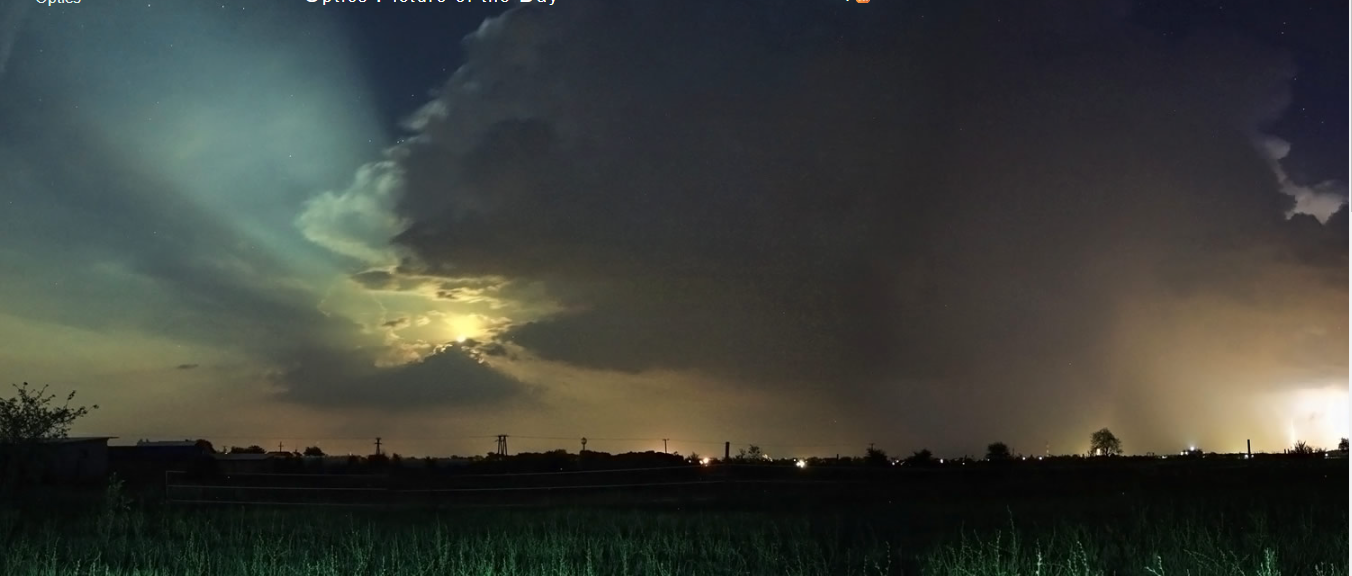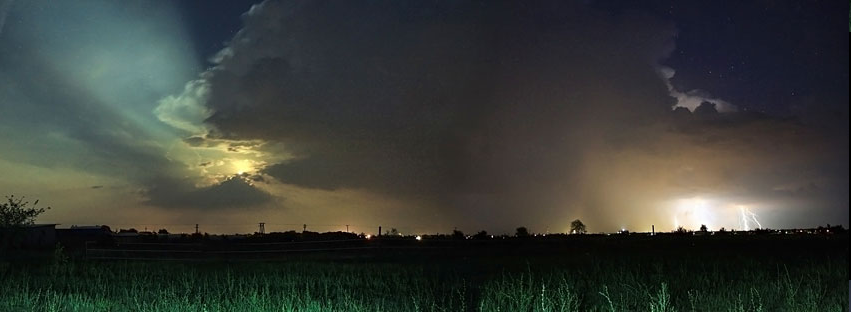Moon rays, lightning - OPOD
Moon Rays, Lightning, and Stars: A Spectacular Atmospheric Display
The mesmerizing combination of moon rays and lightning creates a breathtaking spectacle in the night sky. One such captivating moment was captured by Rafael Schmall in Fejer, Adony, Hungary. In the image, we can observe the striking contrast between the colors of the lightning-lit sky and the ethereal glow suffused by the moon's rays. This unique atmospheric phenomenon offers a glimpse into the fascinating interplay between light, plasma, and celestial bodies.
When lightning strikes, it generates a narrow tube of plasma—an ionized gas—measuring just a few centimeters in diameter but stretching for miles. The temperature within this luminous tube reaches an astonishing 20-30,000 degrees Celsius. As a result, it emits a continuous spectrum of light, accompanied by bright lines of ionized nitrogen and hydrogen atoms. In contrast, moonlight appears yellow to our eyes, but only when compared to other light sources. In reality, the temperature of moonlight is relatively cooler, akin to the surface temperature of the sun, which ranges from 5-6,000 degrees Celsius.
The interplay between moon rays and lightning offers a captivating juxtaposition of colors and temperatures in the night sky. Let's delve deeper into the science behind this extraordinary phenomenon:
The Science Behind Moon Rays and Lightning
-
Plasma Formation: When a lightning bolt discharges, it creates a channel of ionized gas known as plasma. This plasma channel is extremely hot and emits intense light due to the excitation and recombination of atoms within it.
-
Colorful Spectra: The plasma channel produced by lightning emits a continuous spectrum of light. This means that it contains all visible colors, resulting in a vibrant display during thunderstorms. Additionally, bright lines of ionized nitrogen and hydrogen atoms contribute to the unique hues observed in lightning-lit skies.
-
Moonlight's True Colors: Although moonlight appears yellow to our eyes, it is primarily due to a comparison with other light sources. In reality, moonlight is a pale reflection of sunlight, which has a surface temperature of 5-6,000 degrees Celsius. This relatively cooler temperature accounts for the distinct color and intensity of moon rays.
Exploring the Visual Spectacle
The captivating photographs captured by Rafael Schmall provide a visual feast for the eyes. Let's take a closer look at the images to appreciate the beauty and complexity of this atmospheric display:
-
Image 1: The first image showcases the stark contrast between the vibrant colors of the lightning-lit sky and the soft glow of moon rays. The interplay of warm and cool tones creates a visually striking composition.
-
Image 2: In this photograph, we can observe the ethereal glow of the moon illuminating the surrounding clouds. The delicate interplay between light and shadow adds depth and dimension to the scene.
-
Image 3: The final image captures the captivating dance of lightning bolts against the backdrop of a darkened sky. The luminous plasma channels stand out vividly, creating an otherworldly atmosphere.
Appreciating Nature's Light Show
Witnessing the interplay between moon rays and lightning is a truly awe-inspiring experience. Here are a few tips to enhance your appreciation of this natural light show:
-
Find an Optimal Viewing Spot: Seek out locations with unobstructed views of the sky to maximize your chances of observing moon rays and lightning in all their glory.
-
Timing is Key: Thunderstorms and clear moonlit nights provide the best opportunities for witnessing this phenomenon. Stay updated on weather forecasts and lunar phases to plan your viewing accordingly.
-
Capture the Moment: If you're a photography enthusiast, try capturing this enchanting display with your camera. Experiment with different exposure settings and compositions to immortalize the beauty of moon rays and lightning.
In conclusion, the mesmerizing combination of moon rays and lightning offers a captivating glimpse into the intricate interplay of light and plasma in our atmosphere. By understanding the science behind this phenomenon and appreciating its visual splendor, we can deepen our connection with the natural world and marvel at the wonders that unfold above us. So, keep your eyes to the sky and prepare to be spellbound by nature's celestial light show.

Moon Rays - Lightning - Stars
Rafael Schmall caught the scene at Fejer, Adony, Hungary. Scroll the top image.
Contrast the colours of the lightning lit sky and that suffused by the rays of the moon. A lightning stroke results in a tube of plasma, ionised gas, only a few cm diameter but miles long. Its temperature is 20-30,000 Celsius. It emits a continuous spectrum with superimposed bright lines of ionised nitrogen and of hydrogen atoms. Moonlight, yellow - but only by comparison, has approximately the temperature of the sun's surface - a mere 5-6000 Celsius.
Images ©Rafael Schmall, shown with permission


Note: this article has been automatically converted from the old site and may not appear as intended. You can find the original article here.
Reference Atmospheric Optics
If you use any of the definitions, information, or data presented on Atmospheric Optics, please copy the link or reference below to properly credit us as the reference source. Thank you!
-
<a href="https://atoptics.co.uk/blog/moon-rays-lightning-opod/">Moon rays, lightning - OPOD</a>
-
"Moon rays, lightning - OPOD". Atmospheric Optics. Accessed on November 26, 2024. https://atoptics.co.uk/blog/moon-rays-lightning-opod/.
-
"Moon rays, lightning - OPOD". Atmospheric Optics, https://atoptics.co.uk/blog/moon-rays-lightning-opod/. Accessed 26 November, 2024
-
Moon rays, lightning - OPOD. Atmospheric Optics. Retrieved from https://atoptics.co.uk/blog/moon-rays-lightning-opod/.